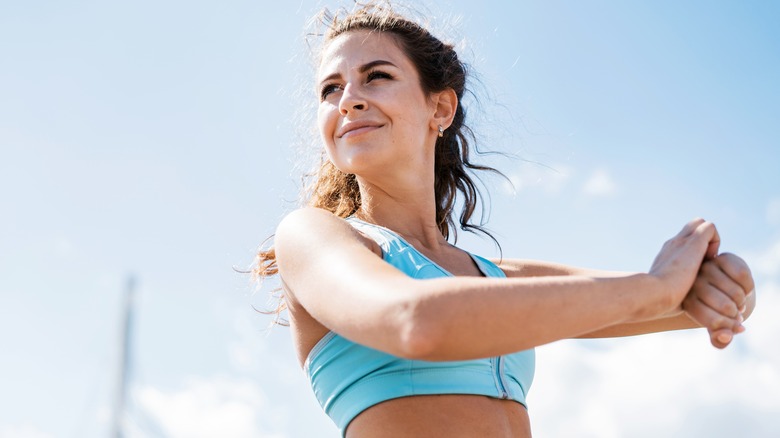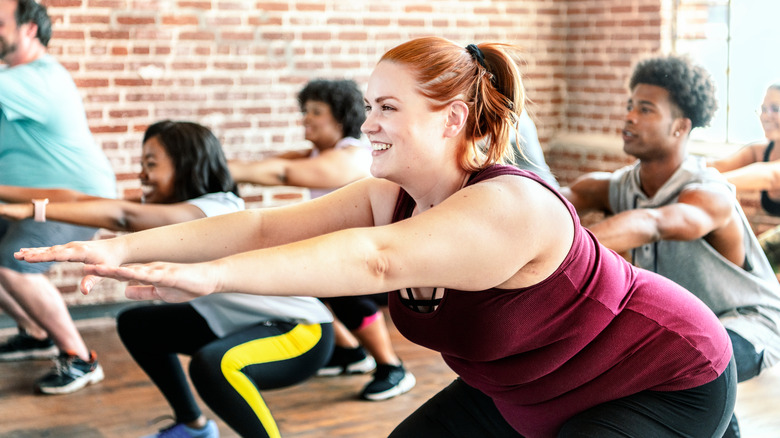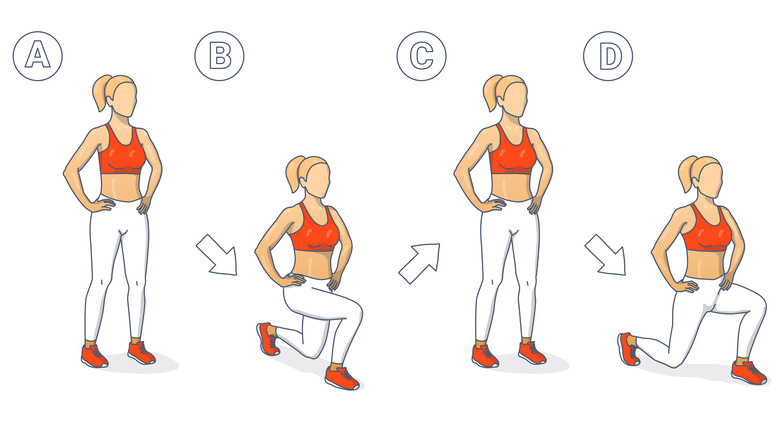Squats Vs Lunges: Which Should You Do?
Leg day can be a daunting prospect if you haven't found your favorite exercises yet, and perfecting your form also takes continued, focused effort. But how do you know if you're training the right way to meet your goals? Depending on whether you are an athlete practicing for your sport or just looking for leg exercises that make a difference in under a month, no workout is one size fits all.
This brings us to the ongoing squat vs lunges debate. Per Vogue, a lunge is defined as having one foot in front of the other with the legs spread, ideally with the front leg bent at 90 degrees while the back is straightened. A squat, on the other hand, requires both feet to be lined up about hip-width apart, keeping the chest up while bending the knees as if you were going to sit down in an invisible chair.
Runners may benefit more from walking lunges since the movement helps elongate and tone muscles while testing their flexibility, according to Healthline. For sports like volleyball, both lunge and squat variations are repeated movements over the course of a game, so training with both can be helpful for increasing your speed and range of motion. Of course, we want to strengthen our muscles not only to reach our potential in our chosen physical activities but also to prevent injury. So, which exercise gets the best overall results: squats or lunges?
Both exercises have major health benefits
Old School Labs has plenty to say about the benefits of squats; their list includes improved core stability and strength, glute activation, better balance, and even increased circulation levels. But lunges can also engage glute muscles and help with overall stability and physical coordination. So, what makes squats stand out? Well, first and foremost, they come pretty naturally to us, according to the outlet.
In fact, toddlers tend to squat to reach the ground rather than bending over. And, of course, our pre-plumbing ancestors were squatting masters. Squats are even linked to regulating bowel movements since they involve straightening the colon Squatty Potty style. However, lunges are important for rehabilitation, as well as injury prevention, according to a study available in the National Library of Medicine.
Byrdie's experts see lunges as a more advanced move than squats, though variations on a moving lunge can be a crucial part of avoiding falls as we age. They suggest the reverse lunge — i.e. stepping back one foot at a time and returning to a central stance — as it can be modified using a wall for stability to ensure proper technique. Obviously, both moves are all about technique, so if you're doing either exercise wrong, you're not only risking injury but you're also unlikely to achieve the desired results.
Lunges may be the key to correcting asymmetry
Although Quick and Dirty Tips sings the praises of both stationary squats and lunges, they point out one major way the latter can correct issues in your body you may not even be aware of. Bodies are often asymmetrical, meaning either the left or right side has stronger muscle groups, more flexibility, or different length limbs. In cases of asymmetry, squats' equalized motion can actually result in the stronger muscle groups on one side of the body compensating for the weaker ones, increasing unevenness and potentially resulting in muscle strain.
Lunges, on the other hand, require the left and right sides of the body to function on their own merits, meaning the muscles on the over-developed side aren't compensating for the weaker side and the latter will hopefully get stronger on its own. Still, both Vogue and Byrdie consider squats better for beginners starting to condition their leg muscles, since they require less coordination than lunges and can include modifications.
Vogue also recommends squats for building glute strength, since your center of gravity is focused on your heels, and pushing your hips forward activates the glutes. But lunges are preferable for sculpting the quadriceps on the front of your thighs since both the front and back legs' thighs are holding the majority of your weight in the movement. Ultimately, Byrdie recommends incorporating both moves into your routine for optimum results.


